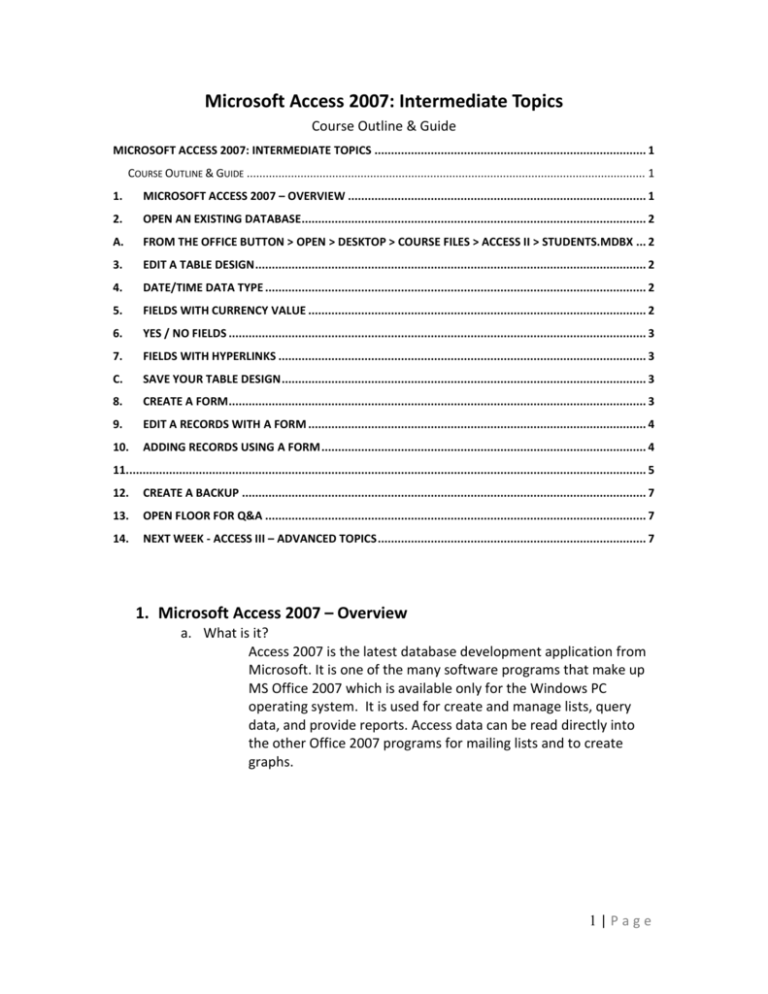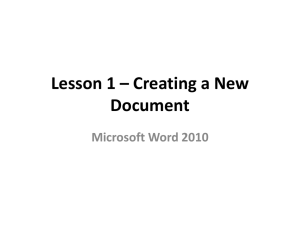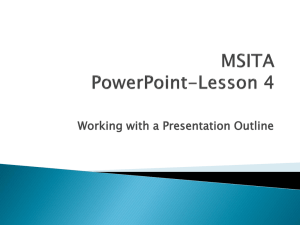Microsoft Access 2007 Beginning Topics
advertisement

Microsoft Access 2007: Intermediate Topics Course Outline & Guide MICROSOFT ACCESS 2007: INTERMEDIATE TOPICS .................................................................................. 1 COURSE OUTLINE & GUIDE .............................................................................................................................. 1 1. MICROSOFT ACCESS 2007 – OVERVIEW .......................................................................................... 1 2. OPEN AN EXISTING DATABASE ........................................................................................................ 2 A. FROM THE OFFICE BUTTON > OPEN > DESKTOP > COURSE FILES > ACCESS II > STUDENTS.MDBX ... 2 3. EDIT A TABLE DESIGN ...................................................................................................................... 2 4. DATE/TIME DATA TYPE ................................................................................................................... 2 5. FIELDS WITH CURRENCY VALUE ...................................................................................................... 2 6. YES / NO FIELDS .............................................................................................................................. 3 7. FIELDS WITH HYPERLINKS ............................................................................................................... 3 C. SAVE YOUR TABLE DESIGN .............................................................................................................. 3 8. CREATE A FORM .............................................................................................................................. 3 9. EDIT A RECORDS WITH A FORM ...................................................................................................... 4 10. ADDING RECORDS USING A FORM .................................................................................................. 4 11............................................................................................................................................................. 5 12. CREATE A BACKUP .......................................................................................................................... 7 13. OPEN FLOOR FOR Q&A ................................................................................................................... 7 14. NEXT WEEK - ACCESS III – ADVANCED TOPICS ................................................................................. 7 1. Microsoft Access 2007 – Overview a. What is it? Access 2007 is the latest database development application from Microsoft. It is one of the many software programs that make up MS Office 2007 which is available only for the Windows PC operating system. It is used for create and manage lists, query data, and provide reports. Access data can be read directly into the other Office 2007 programs for mailing lists and to create graphs. 1|Page 2. Open an Existing Database a. From the Office Button > Open > Desktop > Course Files > Access II > Students.mdbx 3. Edit a table design a. From the Navigation Pane under Tables right click Students and select Design View b. Insert a new field i. Select the Field Name Address ii. From the Ribbon > Design tab > Tools section > click Insert Row iii. Click in the field name area on the inserted blank row 4. Date/Time data type a. What is this? Add a Date/Time, when you need to saves information on a date, time, or both in a standard format. Calculations can be made based on this data. b. New field: i. Field Name: dob ii. Date Type: Date/Time iii. Field Properties: 1. Format: Short date 2. Caption: Date of Birth 3. Default Value: [blank] 4. Required: Yes or No (your choice) 5. Allow Zero Length: Yes or No (your choice) 6. Indexed: No 5. Fields with currency value a. What is this? Add a currency field to a table when you need to store financial data, such as sales, unit cost, or an outstanding balance due. b. New field: i. Field Name: fee ii. Date Type: Currency iii. Field Properties: 1. Format: Currency 2. Caption: Outstanding Fees 3. Required: No 4. Indexed: No 2|Page 6. Yes / No Fields a. What is this? Add a Yes/No field to a table when you need to store binary data, such as the state of a switch, or weather a statement is true or false. b. New field: i. Field Name: finaid ii. Date Type: Yes/No iii. Field Properties: 1. Format: Yes/No 2. Caption: Financial Aid 3. Required: No 4. Indexed: No 7. Fields with hyperlinks a. What is this? Add a hyperlink field to a table when you need to store an address of a webpage or other internet link. b. Add a new field that is a hyperlink iv. Field Name: url v. Date Type: hyperlink vi. Field Properties: 5. Caption: Webpage 6. Required: No 7. Allow Zero Length: Yes 8. Indexed: No 9. Required: No c. Save your table design 8. Create a form a. What are these? i. A method by which you can display and edit data ii. Control application flow iii. Accept input iv. Display messages v. Printing information b. Creating the form i. On the Ribbon, in the Create tab > in the Forms group > select More Forms (down arrow) > Form Wizard ii. Save the table if necessary c. Form Design Wizard 3|Page i. In the Tables/Queries field select the table you wish to create the form for ii. Which fields would you like for this form? In the Available fields: pane select the field you wish to include in your form design by selecting a field and clicking the > to move it to the Selected fields: pane you can select and move all fields by clicking the >> iii. Click Next > iv. What layout would you like for your form? By clicking on the radio buttons you will see an example of the form displayed to the left select the select the Justified radio button v. Click Next > vi. What style would you like? By clicking on the radio buttons you will see an example of the form displayed to the left select the Office radio button vii. Click Next > viii. What title would you like for your form? Enter the name for the form, default the form is created with the same name as the table. Title this form Student Data ix. Leave the open form to view or enter data radio button selected x. Click Finish 9. Edit a records with a form Using the form add the following information to the 6 existing records. Student ID # Date of Financial Outstanding Web Site Birth Aid Fee 111-11-1111 1/1/1960 Yes $100.00 www.cbs.com 222-22-2222 5/15/1969 No $1,000.50 www.sfsu.edu 333-33-3333 2/14/1977 No $2,412.00 www.scifi.com 444-44-4444 3/27/1989 Yes 555-55-5555 4/14/1953 Yes $15.00 www.nbc.com 666-66-6666 6/17/1984 Yes $136.22 www.abc.com 10. Adding records using a form a. Using the form add 3 records I. Create first new record II. Click on the >* at the bottom of the form III. Move on to the next field by pressing TAB 1. Student ID#: 2. First Name: 3. Last Name: 4. Date of Birth: 5. Street Address: 6. City: 4|Page 7. State: 8. Zip Code: 9. College: 10. Financial Aid: 11. Outstanding Fees: 12. Website: 13. Credit Hours: 14. Quality points 11. a. What are they? A method for selecting, sorting and manipulating data extracted from one or more tables or queries. b. Creating a query with sorting i. On the Ribbon, in the Create tab > in the Other group > select Query Design 1. From the Show Table window in the Tables tab select the students 2. Click Add at the bottom of the window 3. Click Close at the bottom of the window a. The top section of the screen will now display the field lists of tables or queries used in this query b. The lower section displays the Design Grid 4. Specifying fields Click the Field: > down arrow to display the list of fields available a. Select sid for the first field (always include your master key in queries so that they may be used as part of future queries) b. Select fname for the second field c. Select lname for the third field d. Select college for the fourth field 5. Under college lick Sort: > down arrow and select asending 6. Run the query and create a results table a. On the Ribbon, in the Design tab > in the Results group > select Run b. To save the results click the save icon on the Quick Tools bar and rename the file to College Sort c. Creating a query with a calculated value i. On the Ribbon, in the Create tab > in the Other group > select Query Design 1. From the Show Table window in the Tables tab select the students 2. Click Add at the bottom of the window 5|Page 3. Click Close at the bottom of the window a. Specifying fields Click the Field: > down arrow to display the list of fields available b. Select sid for the first field (always include your master key in queries so that they may be used as part of future queries) c. Select the next blank field d. On the Ribbon, in the Design tab > in the Query Setup group > select Build to open the Expression Builder i. Expand Tables ii. Select students iii. Double click qpoints iv. Press the / button v. Double click chours vi. Click Ok vii. Press Enter viii. You should now see Expr1: [students]![qpoints]/[students]![chours] on the field line ix. Select the Expr1 portion of the expression and change it to GPA e. Display the properties, on the Ribbon, in the Design tab > in the Show/Hide group > select Property Sheet f. In the Property Sheet pane under Format selected Fixed 4. Run the query and create a results table a. On the Ribbon, in the Design tab > in the Results group > select Run b. To save the results click the save icon on the Quick Tools bar and rename the file to GPA d. Creating a query combining information from multiple sources i. On the Ribbon, in the Create tab > in the Other group > select Query Design 1. From the Show Table window in the Both tab select students, and GPA 2. Click Add at the bottom of the window 3. 4. Click Close at the bottom of the window 5. Specifying fields Click the Field: > down arrow to display the list of fields available a. Select students.sid for the first field b. Next student.college and sort: descending c. Next gpa.gpa and sort: descending 6|Page d. Next student.fname e. Next student.lname 6. Run the query and create a results table a. On the Ribbon, in the Design tab > in the Results group > select Run b. To save the results click the save icon on the Quick Tools bar and rename the file to ClassRank 12.Create a backup a. What is this? A backup is a copy of the original file. This is extremely beneficial if the original file is either damaged or lost b. Close Access c. Save the table or layout if necessary d. Open your My Documents folder for your new database file e. Create a backup i. Move your mouse pointer into the file icon ii. Right-click iii. From the menu choose Copy iv. Move your mouse pointer to an empty area inside the folder v. Right-click vi. From the menu choose Paste vii. Rename the file, sfsu_student_[date].aacdb 13. Open floor for Q&A 14. Next week - Access III – Advanced Topics b. To be determined! 7|Page The following table describes the data types available for fields in Office Access 2007. Data type Stores Size Text Alphanumeric characters Use for text, or text and numbers that are not used in calculations (for example, a product ID). Up to 255 characters. Memo Alphanumeric characters (longer than 255 characters in length) or text with rich text formatting. Use for text greater than 255 characters in length, or for text that uses rich text formatting. Notes, lengthy descriptions, and paragraphs with formatting such as bold or italics are good examples of where you would use a Memo field. Up to 1 gigabyte of characters, or 2 gigabytes of storage (2 bytes per character), of which you can display 65,535 characters in a control. 8|Page Number Numeric values (integers or fractional values). Use for storing numbers to be used in calculations, except for monetary values (use the Currency for data type for monetary values). 1, 2, 4, or 8 bytes, or 16 bytes when used for replication ID. Date/Time Dates and times. Use for storing date/time values. Note that each value stored includes both a date component and a time component. 8 bytes. Currency Monetary values. Use for storing monetary values (currency). 8 bytes. AutoNumber A unique numeric value that Office Access 2007 automatically inserts when a record is added. Use for generating unique values that can be used as a primary key. Note that AutoNumber fields can be incremented sequentially, by a specified increment, or chosen randomly. 4 bytes or 16 bytes when used for replication ID. Yes/No Boolean values. Use for True/False fields that can hold one of two possible values: Yes/No or True/False, for example. 1 bit (8 bits = 1 byte). OLE Object OLE objects or other binary data. Use for storing OLE objects from other Microsoft Windows applications. Up to 1 gigabyte. Attachment Pictures, Images, Binary files, Office files. This is the preferred data type for storing digital images and any type of binary file. For compressed attachments, 2 gigabytes. For uncompressed attachments, approximately 700k, depending on the degree to which the attachment can be compressed. Hyperlink Hyperlinks. Up to 1 gigabyte of 9|Page Lookup Wizard Use for storing hyperlinks to provide single-click access to Web pages through a URL (Uniform Resource Locator) or files through a name in UNC (universal naming convention) format. You can also link to Access objects stored in a database. characters, or 2 gigabytes of storage (2 bytes per character), of which you can display 65,535 characters in a control. Not actually a data type; instead, this invokes the Lookup Wizard. Use to start the Lookup Wizard so you can create a field that uses a combo box to look up a value in another table, query or list of values. Table or query based: The size of the bound column. Value based: The size of the Text field used to store the value. 10 | P a g e





